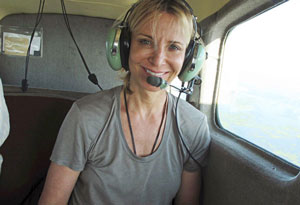What BP Doesn't Want You to See

Susan Casey surveys the Gulf.
When the National Resources Defense Council (NRDC) invited me down to the Gulf last June to witness the effects of the Deepwater Horizon oil spill, I didn't know what to expect. Would I see oiled wildlife, oil on the beaches, oil in the wetlands—would the deadly effects be readily visible? The answer is yes to all of the above, and more: Even the air along the Gulf Coast was saturated with oil, so much so that we brought respirators. At the marina in Grand Isle, Louisiana, I wondered aloud why the cleanup workers weren't wearing them, and some local fishermen voiced their opinion: It looks bad in pictures, so the masks weren't provided.
It looks bad in pictures. While it was hard to see a pelican struggling to lift off on oil-covered wings, or a bottlenose dolphin arcing through the murky water with its crude-soaked baby beside it, I found it even harder to stomach BP's heavy-handed attempts to control media access. And they've gotten a big assist from the U.S. government: Three weeks after my visit it became illegal for journalists to come within 65 feet of any cleanup operations. Anyone violating this new regulation can be slapped with a $40,000 fine, a felony charge, and prison time.
On my second day in the Gulf, I flew out to the rig itself. The pilot, whom I don't name because he was risking his livelihood by ferrying a journalist, had to clear his flight plan with the Coast Guard, the FAA—and a BP representative. Requests to enter that airspace are routinely denied for "safety reasons." I guess you could say I was lucky to be able to see our nation's worst environmental disaster with my own burning eyes.
Next: "You will see black oil, you will see brown oil, you will see red oil, you will see sheets of it"
It looks bad in pictures. While it was hard to see a pelican struggling to lift off on oil-covered wings, or a bottlenose dolphin arcing through the murky water with its crude-soaked baby beside it, I found it even harder to stomach BP's heavy-handed attempts to control media access. And they've gotten a big assist from the U.S. government: Three weeks after my visit it became illegal for journalists to come within 65 feet of any cleanup operations. Anyone violating this new regulation can be slapped with a $40,000 fine, a felony charge, and prison time.
On my second day in the Gulf, I flew out to the rig itself. The pilot, whom I don't name because he was risking his livelihood by ferrying a journalist, had to clear his flight plan with the Coast Guard, the FAA—and a BP representative. Requests to enter that airspace are routinely denied for "safety reasons." I guess you could say I was lucky to be able to see our nation's worst environmental disaster with my own burning eyes.
Next: "You will see black oil, you will see brown oil, you will see red oil, you will see sheets of it"
Photo: Courtesy of Susan Casey



